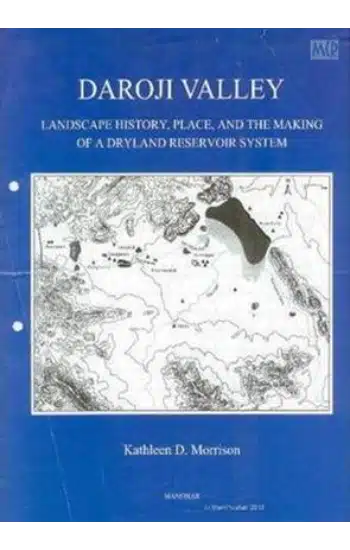
Save: 15%

Save: 15%
Daroji Valley: Landscape History,Place, and the Making of a Dryland Reservoir System
Publisher:
| Author:
| Language:
| Format:
Publisher:
Author:
Language:
Format:
₹1,895 ₹1,610
Save: 15%
In stock
Ships within:
In stock
| Book Type |
|---|
ISBN:
Page Extent:
Landscape history begins with the recognition that both past human experiences and archaeological research are fundamentally focused on specific locales. Locations are defined and made meaningful through processes of place-making, cultural processes that may be multiple and contested but which are never fully divorced from material conditions. Although both scholars and residents of particular places make constant temporal inferences (among others) about settlements, structures, and features, all historical arguments are in fact made on the basis of unified, contemporaneous material (or textual) landscaped in which diverse features jostle together out of time. It is argued here that traditional time-dissected analyses of long-term histories need to be combined with more unified studies of place in which landscape elements made at one time continue to be used, re-made, remembered, and perhaps forgotten. To this end, this volume identifies several South Indian kinds of places such as ashmounds, megaliths, inscriptions, hero stones, temples, and reservoirs which played complex and changing roles in the long-term history of one South Indian place, the Daroji Valley. Located in northern Karnataka, this valley served as a corridor of movement during the Southern Neolothic, an iron-smelting locale in the Early Historic, and most dramatically, as an area of food production for the imperial city of Vijayanagara, especially in the sixteenth century. Home to one of southern Indias most famous chains of runoff-fed reservoirs, this study examines the ways in which Daroji Valley interacted with larger worlds through time, and explores how and why the dramatic agrarian expansion of the Vijayanagara period led to devastating environment consequences.
Landscape history begins with the recognition that both past human experiences and archaeological research are fundamentally focused on specific locales. Locations are defined and made meaningful through processes of place-making, cultural processes that may be multiple and contested but which are never fully divorced from material conditions. Although both scholars and residents of particular places make constant temporal inferences (among others) about settlements, structures, and features, all historical arguments are in fact made on the basis of unified, contemporaneous material (or textual) landscaped in which diverse features jostle together out of time. It is argued here that traditional time-dissected analyses of long-term histories need to be combined with more unified studies of place in which landscape elements made at one time continue to be used, re-made, remembered, and perhaps forgotten. To this end, this volume identifies several South Indian kinds of places such as ashmounds, megaliths, inscriptions, hero stones, temples, and reservoirs which played complex and changing roles in the long-term history of one South Indian place, the Daroji Valley. Located in northern Karnataka, this valley served as a corridor of movement during the Southern Neolothic, an iron-smelting locale in the Early Historic, and most dramatically, as an area of food production for the imperial city of Vijayanagara, especially in the sixteenth century. Home to one of southern Indias most famous chains of runoff-fed reservoirs, this study examines the ways in which Daroji Valley interacted with larger worlds through time, and explores how and why the dramatic agrarian expansion of the Vijayanagara period led to devastating environment consequences.
About Author
Reviews
There are no reviews yet.
Related products
Physics Set Of 2 Books: Vol.1 And Vol. 2
Save: 25%
Harappan Studies: Recent Researches In South Asian Archaeology (Vol. I)
Save: 15%
RELATED PRODUCTS
Harappan Studies: Recent Researches In South Asian Archaeology (Vol. I)
Save: 15%
VEDIC BELIEFS AND PRACTICES THROUGH ARTHAVADA (Set of 2 Vols.)
Save: 15%



Reviews
There are no reviews yet.